When is the best time to visit the beautiful islands of the Philippines? Is it during the dry season, when the weather is warm and activities like diving and snorkeling are at their best? Or perhaps during the wet season, when the landscapes are lush and the crowds are fewer? The Philippines offers a diverse range of seasons throughout the year, each with its own unique charm and opportunities for exploration. So, when should you plan your trip to this tropical paradise?
Key Takeaways:
- The best time to visit the Philippines is from December to February, during the dry season.
- The dry season offers clear skies, warm weather, and good visibility for activities like diving and snorkeling.
- The wet season, from June to November, offers lush landscapes, fewer visitors, and lower prices.
- Each month in the Philippines has its own festivals and cultural attractions to explore.
- Plan your trip according to your interests and make the most of your visit to this tropical paradise.
The Dry Season in the Philippines
The dry season in the Philippines, which spans from December to May, is widely regarded as the best time to visit the country. This period showcases the Philippines at its finest, with clear skies, warm weather, and optimal visibility for various outdoor activities, including diving and snorkeling. The absence of heavy rainfall makes it ideal for exploring the stunning natural wonders of the Philippines.
During the dry season, beach enthusiasts can indulge in the country’s pristine coastlines, basking under the sun and enjoying the crystal-clear waters. Hiking enthusiasts will also find this time favorable, with pleasant temperatures and dry trails perfect for exploring the country’s lush mountains and picturesque landscapes.
However, it’s important to keep in mind that the dry season is the peak time for travel, attracting a significant influx of tourists. As a result, popular beach resorts can become crowded, and prices may be higher compared to other times of the year. Consider making advance reservations to secure accommodations and plan ahead to avoid any inconvenience.
The dry season not only provides ideal conditions for outdoor activities but also offers an opportunity to experience the rich cultural heritage of the Philippines. Festivals such as the Panagbenga Festival in Baguio City and the Pahiyas Festival in Lucban showcase the vibrant traditions and unique artistry of the Filipino people.
Benefits of visiting during the dry season:
- Clear skies and warm weather
- Optimal visibility for diving and snorkeling
- Ideal for beach activities and hiking
- Opportunity to explore natural wonders
- Cultural festivals and events
| Month | Average Temperature (°F) | Precipitation |
|---|---|---|
| December | 77 – 88 | Low |
| January | 75 – 88 | Low |
| February | 75 – 88 | Low |
| March | 77 – 90 | Low |
| April | 79 – 92 | Low |
| May | 79 – 92 | Low |
Overall, the dry season in the Philippines provides an opportunity to embrace the country’s natural beauty, indulge in thrilling adventures, and immerse oneself in the vibrant culture. Whether you’re seeking relaxation on white sandy beaches or embarking on exhilarating hiking trails, the dry season offers the perfect conditions for a memorable trip to the Philippines.
The Wet Season in the Philippines
The wet season in the Philippines spans from June to November. While rainfall is common during this period, it is typically intermittent and rarely interrupts travel plans. Despite the rain, the wet season offers its own unique allure, with lush landscapes, fewer visitors, and more affordable prices.
One of the advantages of visiting during the rainy season is the opportunity to explore cultural attractions and partake in festivals. The Philippines boasts a rich heritage, and this is the perfect time to immerse yourself in the vibrant local culture.
Adventure enthusiasts will find plenty to do during the wet season. White-water rafting and surfing are popular activities that take advantage of the increased water levels. The rivers are at their wildest, providing exhilarating rafting experiences, while the waves become ideal for surfing.
It’s worth noting that some areas may be challenging to access due to heavy rains, and certain resorts may temporarily close. However, with careful planning and research, you can still enjoy a memorable trip to the Philippines during the wet season.
In conclusion, the wet season in the Philippines offers its own unique beauty and experiences. While it may not be the conventional choice for many travelers, it presents an opportunity to explore the country in a different light. With fewer crowds, lower prices, and lush landscapes, the wet season can be a delightful time to visit. Embrace the rain, immerse yourself in the culture, and create lasting memories in this tropical haven.
Visiting the Philippines in January
January is truly the best time to visit the Philippines. As one of the peak months of the dry season, January offers visitors cooler temperatures and minimal rainfall, making it the perfect time to explore the breathtaking beauty of this tropical paradise.
But it’s not just the weather that makes January so special in the Philippines. This month is also home to several vibrant festivals that showcase the rich cultural heritage of the country. One of the most famous festivals in January is the Ati-Atihan Festival, held in Kalibo, Aklan. Known as the “Mother of All Philippine Festivals,” Ati-Atihan is a colorful celebration of dance and music, with locals donning traditional costumes and beautifully painted faces.
“The Ati-Atihan Festival is a must-see for anyone visiting the Philippines in January. The vibrant street dancing and infectious energy of the festival create an unforgettable experience for travelers.”
Another festival worth experiencing is the Dinagyang Festival in Iloilo City. Recognized as one of the country’s best cultural festivals, Dinagyang showcases a mesmerizing display of street dancing, with participants dressed as tribesmen in elaborate costumes adorned with beads and feathers.
Lastly, the Feast of the Black Nazarene, held in Quiapo, Manila, is a religious procession that attracts millions of devotees from all over the country. With fervent prayers, spirited chants, and a grand procession, this festival highlights the unwavering faith of the Filipino people.
Visiting the Philippines in January allows you not only to enjoy the idyllic weather and breathtaking scenery but also to immerse yourself in the vibrant atmosphere of these incredible festivals. It’s a truly unforgettable experience that will leave you with cherished memories for a lifetime.
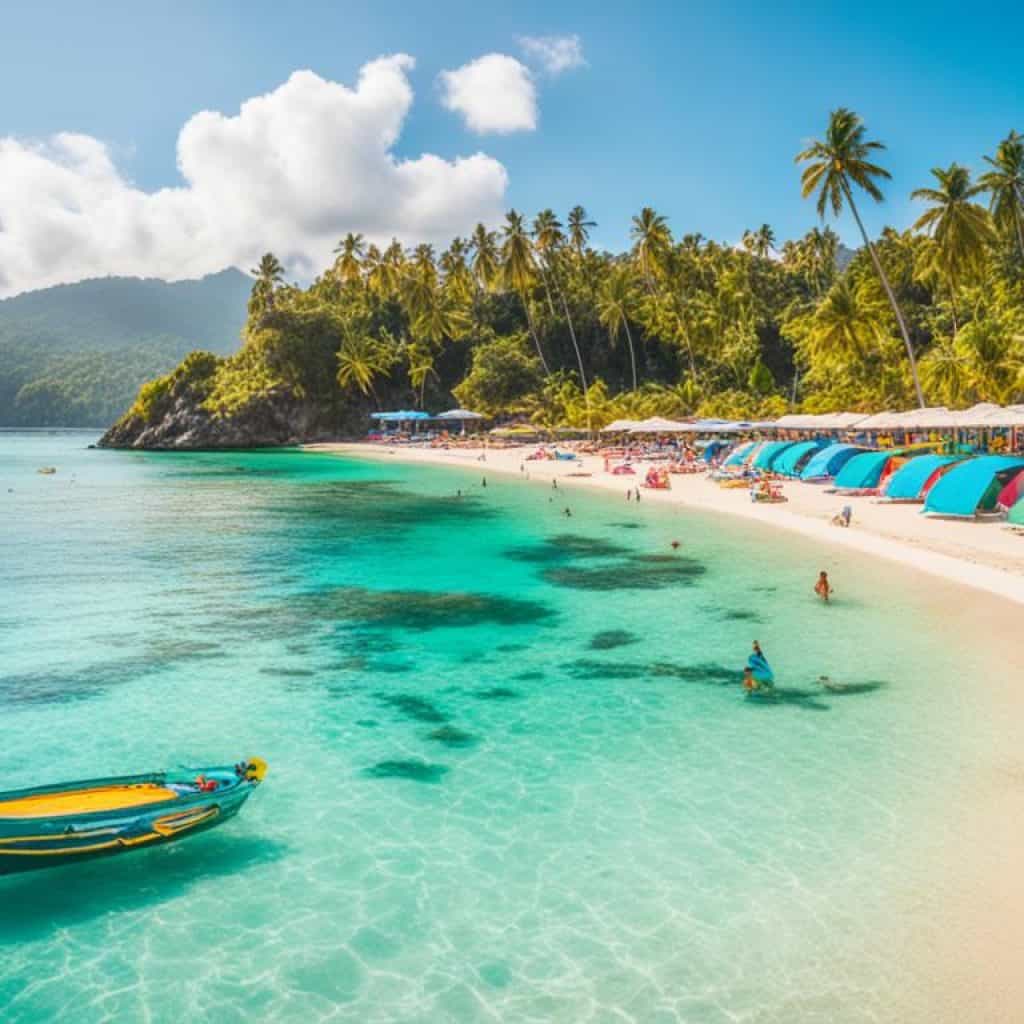
The Ati-Atihan Festival
The Ati-Atihan Festival is held annually in Kalibo, Aklan, in January. It is a week-long celebration characterized by vibrant street dancing and tribal performances. The festival has deep historical and religious roots, dating back to the 13th century when Malay settlers came to the island to trade with the local Ati tribe. Today, locals and tourists alike come together to honor the Santo Niño (Child Jesus) and celebrate the harmonious relationship between the Ati people and the early Malay settlers.
| Festival: | Ati-Atihan Festival |
|---|---|
| Location: | Kalibo, Aklan |
| Date: | Third Sunday of January |
| Highlights: |
|
During the festival, the streets of Kalibo come alive with the rhythmic beat of drums and the joyful shouts of participants dressed in colorful costumes. The highlight of the event is the street dancing competition, where groups from different barangays (villages) showcase their elaborate choreography, traditional costumes, and face paint. The dancers move to the sound of drums, showcasing their skill and artistry while paying homage to their cultural heritage.
The Ati-Atihan Festival is not just a cultural spectacle; it’s also a time of joyous celebration, with locals and tourists indulging in delicious street food, lively music, and traditional games. The festival creates a vibrant and inclusive atmosphere, bringing people together to experience the unique spirit of the Philippines.
Visiting the Philippines in February
February is another wonderful time to visit the Philippines. It is still within the dry season, with slightly cooler temperatures compared to January. This month offers the opportunity to fully explore the country without the crowds.
The Sinulog Festival in Cebu City
One of the highlight festivals in February is the Sinulog Festival, celebrated in Cebu City. It features a grand parade, vibrant costumes, and the iconic Sinulog dance. This festival is a must-see for anyone looking to immerse themselves in the rich cultural traditions of the Philippines. The Sinulog Festival is a celebration of faith and gratitude, paying homage to the Santo Niño or the Child Jesus.
The Sinulog Festival showcases the creativity and resilience of the Filipino people. It is a time when locals and visitors come together to celebrate, dance, and offer prayers. The festival’s highlight is the grand street parade, where participants dressed in colorful costumes perform the Sinulog dance. The infectious rhythm of the drums and the vibrant energy of the dancers create a truly mesmerizing spectacle.
Aside from the Sinulog Festival, February offers a range of cultural experiences and natural wonders to explore in the Philippines. From pristine beaches to breathtaking landscapes, there is something for everyone to enjoy during their visit.
| Reasons to Visit the Philippines in February |
|---|
| 1. Pleasant weather with slightly cooler temperatures compared to January. |
| 2. Less crowded attractions and tourist spots. |
| 3. The vibrant Sinulog Festival in Cebu City. |
| 4. Opportunity to explore the country’s rich cultural heritage. |
| 5. Beautiful beaches and natural landscapes to enjoy. |
Whether you’re seeking cultural immersion, beach relaxation, or outdoor adventures, February offers the perfect conditions for an unforgettable trip to the Philippines. Don’t miss the chance to experience the vibrant festivities and discover the beauty of this tropical paradise.
Visiting the Philippines in March
March is a great time to visit the Philippines, as it offers fantastic weather for outdoor activities and sightseeing. Although it may be slightly hotter compared to February, the dry and sunny climate creates the perfect conditions for exploring the beautiful islands and relaxing on the stunning beaches. Take advantage of this month to immerse yourself in the local culture and experience the natural wonders of the Philippines.
“March is the perfect time to explore the captivating beauty of the Philippines and bask in the warm rays of the tropical sun.”
While there may not be any major festivals in March, this month provides an opportunity to indulge in the peaceful ambiance of the country with fewer crowds and a laid-back atmosphere. Whether you’re fascinated by historical sites, water sports, or simply unwinding on pristine beaches, March offers plenty of options to cater to your preferences.
Embark on a memorable island-hopping adventure, where you can discover hidden lagoons, crystal-clear waters, and vibrant coral reefs teeming with marine life. Engage with the friendly locals, sample delicious traditional cuisine, and be mesmerized by the diverse landscapes that range from picturesque mountains to lush rice terraces.
If you’re seeking a tranquil getaway, head to lesser-known destinations like Bohol or Siargao, where you can find idyllic beaches, serene nature reserves, and charming local communities. Capture the awe-inspiring beauty of the Chocolate Hills in Bohol or ride the epic surf breaks in Siargao.
“March in the Philippines beckons adventurers and nature enthusiasts to embark on unforgettable explorations and create memories that will last a lifetime.”
Take a break from the bustling city life and immerse yourself in the tranquility of the Philippines’ untouched landscapes. From the Banaue Rice Terraces to the stunning beaches of Boracay, March provides an excellent opportunity to fully appreciate the pristine beauty of this tropical paradise.
“The Philippines awaits in March with its stunning natural beauty, warm hospitality, and countless opportunities for adventure.”
Visiting the Philippines in April
April is one of the hottest months in the Philippines and a popular time to plan your visit. During this month, the dry season is still ongoing, offering ideal weather conditions for enjoying beach activities and water sports. The country’s stunning natural beauty is on full display, and you can explore renowned destinations like Palawan, Boracay, and El Nido.
While there are no major festivals in April, you can immerse yourself in the breathtaking landscapes and cultural experiences that the Philippines has to offer. From picturesque white sandy beaches to crystal-clear turquoise waters, April is the perfect time to relax, unwind, and soak in the tropical paradise.
For adventure enthusiasts, April provides ample opportunities for snorkeling, diving, and various watersports in the warm coastal waters. Explore the vibrant marine life, swim among colorful coral reefs, or simply bask in the sunshine on the pristine shores.
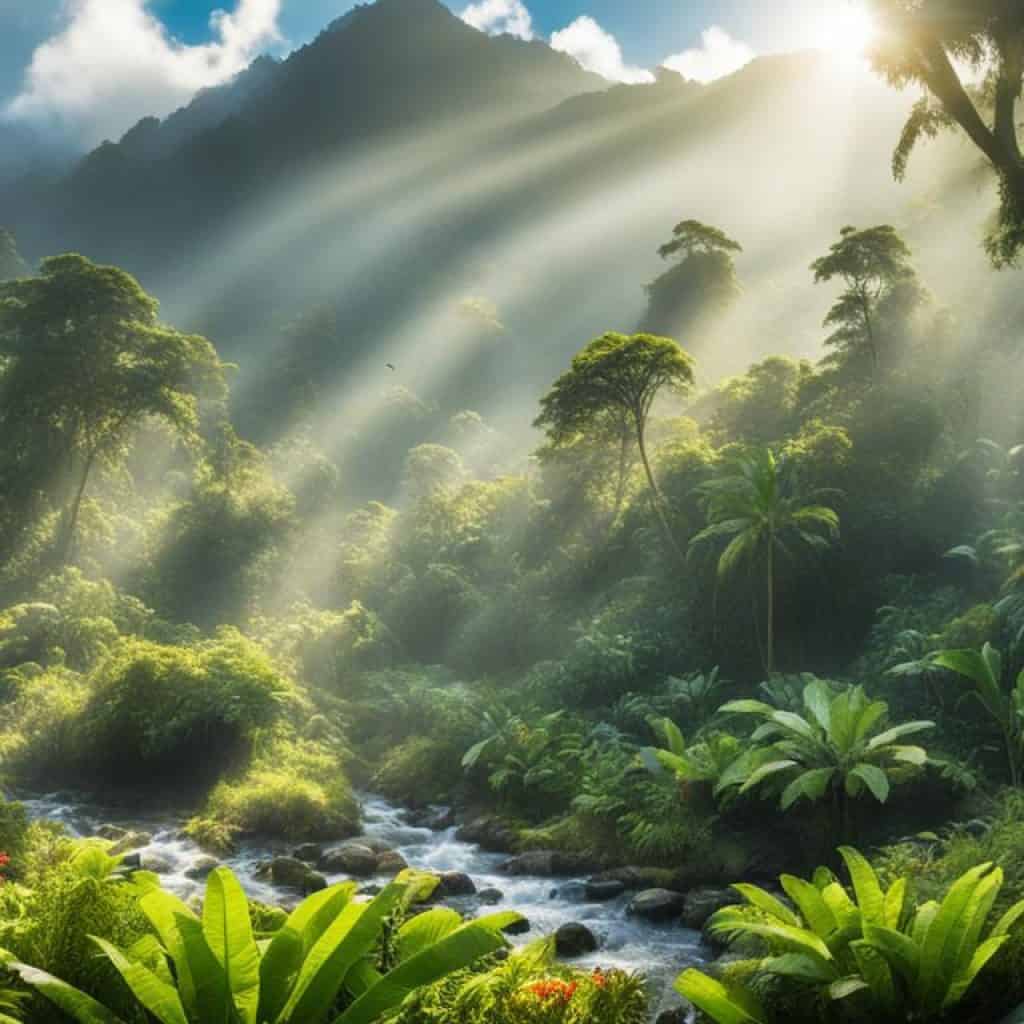
Discover the natural wonders of the Philippines in April, when the dry season allows you to witness the country’s breathtaking beauty in its full glory. From its magnificent beaches to its vibrant marine life, a visit to the Philippines in April promises unforgettable experiences.
April Highlights:
- Enjoy the hottest temperatures and dry weather for beach activities and water sports.
- Experience the stunning natural beauty of destinations like Palawan, Boracay, and El Nido.
- Immerse yourself in the charming culture and warm hospitality of the Filipino people.
Recommended Activities:
- Indulge in snorkeling and diving excursions to explore the diverse marine life.
- Take leisurely walks along the beautiful beaches and soak in the breathtaking scenery.
- Visit the local markets and sample delicious Filipino cuisine.
Travel Tips:
- Stay hydrated and protect yourself from the sun by applying sunscreen and wearing a hat.
- Book your accommodations and flights in advance, as April is a popular time to visit.
- Pack lightweight and breathable clothing suitable for the tropical climate.
| Month | Weather | Festivals |
|---|---|---|
| April | Hot and dry | No major festivals |
Visiting the Philippines in May
May is a remarkable month to visit the Philippines. As the country transitions from the dry season to the wet season, you can experience the beauty of nature in full bloom. Although there may be occasional rain showers, it’s still a great time to explore and immerse yourself in the breathtaking landscapes that the Philippines has to offer.
The lush greenery and fewer crowds make May an ideal time for nature lovers. Whether you’re exploring the cascading waterfalls, trekking through the lush rainforests, or simply admiring the vibrant flora and fauna, you’ll be enchanted by the abundance of natural wonders.
“The beauty of the Philippines in May is unparalleled. Despite the sporadic rain showers, it’s a great time to witness the lush landscapes and connect with nature in a profound way. “
One of the highlights of visiting the Philippines in May is the Mayon Festival. This festival is a vibrant celebration that pays tribute to the iconic Mayon Volcano, located in Legazpi City. It features colorful parades, street performances, and cultural presentations. You can immerse yourself in the rich heritage and traditions of the region while enjoying the festivities.
To give you a better idea of the overall weather conditions and average temperatures in May, take a look at the table below:
| City | Average Temperature (°F) | Rainfall (inches) |
|---|---|---|
| Manila | 80-93 | 5.4 |
| Cebu | 79-91 | 2.9 |
| Boracay | 80-92 | 6.5 |
| Palawan | 79-91 | 4.7 |
As you can see from the table, May generally has warm temperatures ranging from 79°F to 93°F across different cities in the Philippines. Rainfall is also moderate, adding to the lushness of the surroundings. Despite the occasional rain showers, there are still plenty of opportunities to explore and enjoy the beauty of the country.
So, if you’re a nature enthusiast and want to witness the blooming landscapes of the Philippines while immersing yourself in the Mayon Festival, May is the perfect month to visit the country. Pack your bags, prepare your raincoat, and get ready for an unforgettable adventure.
Visiting the Philippines in June
June marks the beginning of the wet season in the Philippines. While rainfall increases, it is usually not continuous and does not hinder outdoor activities. This month provides a great opportunity to explore popular destinations like Palawan, the Southern Visayas, and Mindanao, which are less prone to typhoons.
One of the notable festivals celebrated in June is the Pintados-Kasadayan Festival in Tacloban City. This vibrant event showcases the rich cultural heritage of the region, featuring colorful street parades, traditional dances, and intricately painted bodies symbolizing ancient Filipino warriors. It’s a captivating display of traditions and an excellent way to immerse yourself in the Filipino culture.
Despite the onset of the wet season, June is still a favorable time to visit the Philippines. The unique festivals, less crowded tourist spots, and cultural experiences make it an appealing month for travelers seeking an authentic and immersive adventure.
| Pros | Cons |
|---|---|
|
|
Don’t let the beginning of the wet season deter you from exploring the beauty and culture of the Philippines in June. With proper planning and flexibility, you can still have a memorable and enjoyable trip.
Visiting the Philippines in July
July is an exciting time to visit the Philippines, despite being within the rainy season. While the rainfall may be slightly heavier compared to June, it doesn’t have to dampen your plans for outdoor activities and cultural exploration. There are plenty of destinations and festivals to discover during this month, making it a memorable time to visit.
Exploring the Southern Visayas
If you’re seeking stunning beaches, crystal-clear waters, and vibrant marine life, the Southern Visayas region is a must-visit in July. This area encompasses popular islands such as Bohol, Cebu, and the stunning Chocolate Hills. Dive enthusiasts will be delighted by the opportunity to explore world-class dive sites, including Apo Island and Moalboal. Despite the occasional rainfall, the Southern Visayas offers breathtaking natural beauty that will leave you in awe.
Immersing Yourself in Manila’s Cultural Scene
A visit to Manila, the capital city of the Philippines, is a fantastic way to immerse yourself in the country’s rich cultural heritage. Explore historical sites such as Intramuros, a fortified complex that showcases Spanish colonial architecture. Visit the National Museum of the Philippines, where you can admire valuable artifacts and learn about the country’s history. Despite the rain, Manila’s vibrant arts and food scene will keep you entertained throughout your visit.
Catching the Best Waves in Siargao Island
Surfers, rejoice! July is the perfect time to head to Siargao Island, known as the “Surfing Capital of the Philippines.” This tropical paradise offers world-class waves and a laid-back atmosphere that attracts surfers from around the globe. Whether you’re a beginner or an experienced surfer, Siargao’s famous surf breaks, such as Cloud 9, will provide an exhilarating experience. The island’s unique blend of breathtaking scenery and vibrant surf culture makes it a top choice for wave enthusiasts.
| Destination | Activities | Weather |
|---|---|---|
| Southern Visayas | Beach hopping, diving, snorkeling, exploring Chocolate Hills | Intermittent rain, warm temperatures |
| Manila | Exploring historical sites, visiting museums, enjoying the arts scene | Rainfall throughout the month, mild temperatures |
| Siargao Island | Surfing, island hopping, relaxing on the beach | Intermittent rain, warm temperatures |
Despite the rainy season, July offers unique experiences and adventures in the Philippines. Whether you choose to explore the Southern Visayas, immerse yourself in Manila’s cultural scene, or catch the best waves in Siargao Island, you’re sure to have an unforgettable trip. With proper planning and a sense of adventure, you can make the most of your visit to the Philippines in July.
Visiting the Philippines in August
In August, despite being within the wet season in the Philippines, it’s still a fantastic time to explore the country’s rich cultural heritage and visit captivating destinations like Manila, Cebu, and the Mindanao region. While the rain may be more frequent, it typically doesn’t disrupt travel plans, allowing you to enjoy all that the Philippines has to offer.
August is also known for hosting the Allaw Ta Apo Sandawa Festival in Kidapawan City, which pays tribute to the sacred Mount Apo. This vibrant festival showcases the traditional music, dances, and handicrafts of the indigenous tribes in the area. It’s a captivating celebration that allows you to immerse yourself in the local culture and witness the vivid colors and joyful atmosphere of the festival.
If you’re planning a visit to the Philippines in August, make sure to include the Allaw Ta Apo Sandawa Festival in your itinerary. It’s an excellent opportunity to witness unique cultural traditions and create unforgettable memories in this tropical paradise.
Why Visit the Philippines in August?
- Experience the vibrant Allaw Ta Apo Sandawa Festival in Kidapawan City
- Explore the bustling city of Manila and discover its historical and modern attractions
- Visit Cebu, known for its stunning beaches, resorts, and historical landmarks
- Discover the natural wonders and diverse landscapes of the Mindanao region
“August in the Philippines is a captivating time to embrace the country’s cultural heritage and witness the Allaw Ta Apo Sandawa Festival. Immerse yourself in the vibrant festivities, explore captivating destinations, and create memories that will last a lifetime.”
Visiting the Philippines in September
September is still part of the wet season in the Philippines, but don’t let that discourage you from planning your visit. This month offers unique travel experiences and opportunities to immerse yourself in the rich culture of the archipelago. While the rain may be heavier compared to other months, it usually doesn’t last all day, allowing for enjoyable adventures.
If you’re a budget-conscious traveler, September is an ideal time to visit the Philippines. With fewer tourists during this off-peak season, you can find great deals on accommodations, flights, and activities. Take advantage of the lower prices and explore the country without breaking the bank.
One of the highlights of visiting the Philippines in September is the Lanzones Festival in Lambajao, Camiguin Island. Celebrated every third week of the month, this festival showcases the local culture and pays tribute to the Lanzones fruit, a sweet tropical delicacy beloved by Filipinos. The festival features street parades, dance performances, and, of course, the joyous consumption of Lanzones fruit. It’s a vibrant celebration that shouldn’t be missed!
During your visit, make sure to indulge in the local cuisine, experience the warmth of Filipino hospitality, and explore the natural beauty of the islands. Whether you’re trekking through lush rainforests, snorkeling in crystal-clear waters, or discovering centuries-old Spanish colonial architecture, September offers a unique blend of cultural immersion and adventure.
Why Visit the Philippines in September?
“September in the Philippines is a hidden gem for travelers seeking authentic cultural experiences and budget-friendly trips. Explore the vibrant festivities of the Lanzones Festival and savor the taste of the Philippines, all while enjoying the charm of a quieter tourist season.”
Plan your trip to the Philippines in September and discover the beauty of a country that never fails to captivate with its warmth, diversity, and natural wonders.
Top Experiences in the Philippines in September:
- Immerse yourself in the lively atmosphere of the Lanzones Festival in Lambajao, Camiguin Island.
- Discover the stunning landscapes and rich biodiversity of the Philippines’ national parks and nature reserves.
- Trek through lush rainforests and experience the thrill of swimming in hidden waterfalls.
- Snorkel or dive in the world-renowned marine sanctuaries and witness the vibrant underwater ecosystems.
- Explore the historic cities of Manila, Cebu, and Iloilo, and marvel at their architectural treasures.
Don’t miss out on the unique experiences and cultural festivities that await you in the Philippines in September. It’s the perfect time to create unforgettable memories and explore this tropical paradise in all its glory.
Visiting the Philippines in October
October is an exciting time to visit the Philippines, despite being within the wet season. While rain may be more frequent, it typically doesn’t disrupt travel plans significantly. This month presents an excellent opportunity for travelers to immerse themselves in the vibrant culture and traditions of the country by participating in various festivals.
Experience the Festivals in October
The month of October in the Philippines is filled with lively festivals that showcase the rich heritage and diversity of the Filipino people. Here are three notable festivals celebrated during this month:
-
Masskara Festival in Bacolod
“The Masskara Festival in Bacolod is a captivating celebration known for its elaborate masks and vibrant street performances. The locals don colorful costumes and intricately designed masks as they dance through the streets, exuding joy and energy. This festival is an embodiment of Bacolod’s resilience and optimism even in the face of challenges, making it a truly unforgettable experience for visitors.”
-
Pahiyas Festival in Lucban
“The Pahiyas Festival in Lucban is an exceptional cultural event that showcases the region’s agricultural abundance. During this festival, houses are adorned with colorful rice decorations, fruits, vegetables, and other agricultural products as a form of thanksgiving. Visitors can witness the creativity and ingenuity of the locals as they transform their homes into stunning works of art.”
-
Pintados-Kasadayan Festival in Tacloban City
“The Pintados-Kasadayan Festival in Tacloban City is a celebration of the past and an homage to the region’s indigenous roots. Participants paint their bodies with intricate patterns to represent ancient warriors. The festival showcases traditional dances, music, and rituals that honor the region’s cultural heritage. It’s a visually captivating event that offers a glimpse into the rich history of the Philippines.”
Attending these festivals provides an extraordinary opportunity to witness the vibrant spirit of the Filipino people and experience their warm hospitality. By immersing yourself in these cultural celebrations, you’ll create lasting memories and gain a deeper appreciation for the traditions that make the Philippines truly unique.
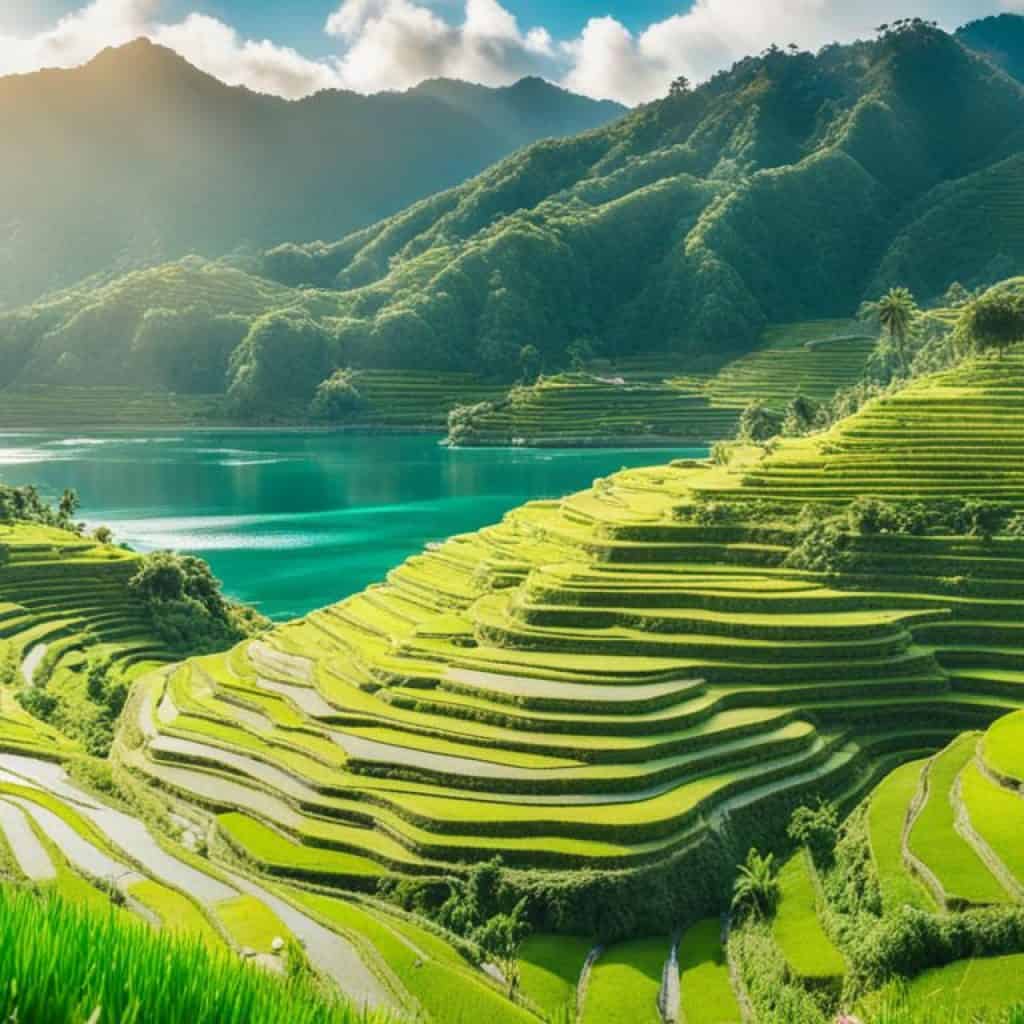
| Festival | Location | Date |
|---|---|---|
| Masskara Festival | Bacolod | October 1-31 |
| Pahiyas Festival | Lucban | May 15 |
| Pintados-Kasadayan Festival | Tacloban City | June 29 |
The table above provides an overview of the festivals happening in October, including their locations and dates. It’s important to note that festivals in the Philippines often have variations in their schedules, so it’s recommended to check the latest updates and plan your trip accordingly to ensure you don’t miss out on these vibrant cultural experiences.
Visiting the Philippines in November
November is a wonderful time to visit the Philippines, especially for travelers seeking fewer crowds and a calming atmosphere. As the wet season comes to an end, rainfall decreases compared to the previous months, making it an ideal time for outdoor activities and exploration. The weather remains pleasant, with temperatures ranging from 77°F to 88°F (25°C to 31°C).
In November, you can take advantage of the tranquil atmosphere to explore popular destinations like Manila, Cebu, and Siargao Island. Marvel at the historical landmarks and vibrant street markets in Manila, or embrace nature’s beauty while hiking through breathtaking landscapes in Cebu. For adventure seekers, Siargao Island offers world-class surfing spots and stunning beaches.
While there may not be major festivals happening in November, you can still immerse yourself in the rich cultural heritage of the Philippines. Interact with locals, savor traditional cuisine, and discover the diverse traditions and customs that make this country so unique.
“November is the perfect time to experience the tranquility and beauty of the Philippines. Embrace the serenity of the post-rainy season and embark on a journey of discovery and relaxation.”
Recommended Destinations in November:
- Manila: Explore the historical sites, such as Intramuros, and indulge in local cuisine at vibrant street food markets.
- Cebu: Discover the stunning natural landscapes, dive into crystal-clear waters, and immerse yourself in the cultural heritage of the region.
- Siargao Island: Catch the world-famous waves, relax on pristine beaches, and embrace the laid-back island vibes.
Plan your visit to the Philippines in November for a peaceful and unforgettable experience. Enjoy the beauty of the landscape, engage with the welcoming locals, and create lasting memories in this tropical paradise.
| Pros of visiting the Philippines in November | Cons of visiting the Philippines in November |
|---|---|
| – Pleasant weather, with decreased rainfall. | – No major festivals. |
| – Fewer crowds and tranquil atmosphere. | – Some areas may still experience intermittent rain showers. |
| – Lower travel costs and accommodation rates. |
Visiting the Philippines in December
December marks the beginning of the dry season in the Philippines, making it one of the best times to visit this breathtaking tropical destination. With pleasant weather and fully accessible attractions, December offers a perfect opportunity to explore the diverse wonders of the country.
One of the highlights of visiting the Philippines in December is experiencing the vibrant Christmas festivities. Filipinos celebrate this joyful season with great enthusiasm, and you’ll be swept up in the festive spirit everywhere you go. From dazzling lights and beautifully adorned streets to lively carol singing and sumptuous feasts, you’ll truly feel the warmth of the season.
An event not to be missed during December is the Giant Lantern Festival in San Fernando, Pampanga. This dazzling festival showcases intricately designed and illuminated lanterns, each one more spectacular than the last. The Giant Lantern Festival is a feast for the eyes and a testament to the Filipino spirit of unity and creativity.
“The Giant Lantern Festival is a mesmerizing celebration of light, creativity, and the rich cultural heritage of the Philippines.”
– Local Travel Guide
Aside from the festivities, December offers plenty of opportunities to explore the natural beauty of the Philippines. From idyllic beaches and turquoise waters to lush rainforests and enchanting islands, the country is a paradise for outdoor enthusiasts. Snorkeling, diving, hiking, and island hopping are just a few of the activities you can indulge in during your December visit.
Whether you want to immerse yourself in the local culture, enjoy spectacular landscapes, or simply relax on pristine beaches, December is an ideal time to experience the best of the Philippines.
Conclusion
The Philippines is a destination that offers a vibrant mix of seasons and festivals throughout the year. While the best time to visit is during the dry season from December to February, each month brings its own unique experiences and opportunities for exploration.
Whether you’re a beach enthusiast, an avid hiker, or a cultural explorer, the Philippines has something for everyone. During the dry season, you can enjoy pleasant temperatures and minimal rainfall, perfect for beach activities and outdoor adventures.
However, don’t overlook the other months of the year. The wet season in the Philippines, although unpredictable, offers lush landscapes, fewer crowds, and lower prices. It’s a great time to immerse yourself in local festivals, explore cultural attractions, and engage in exciting activities like surfing and white-water rafting.
Plan your trip to the Philippines according to your interests and preferences. Whether it’s basking in the sun on pristine beaches, hiking through breathtaking landscapes, or celebrating the country’s rich cultural heritage, the Philippines promises a memorable and diverse experience throughout the year.
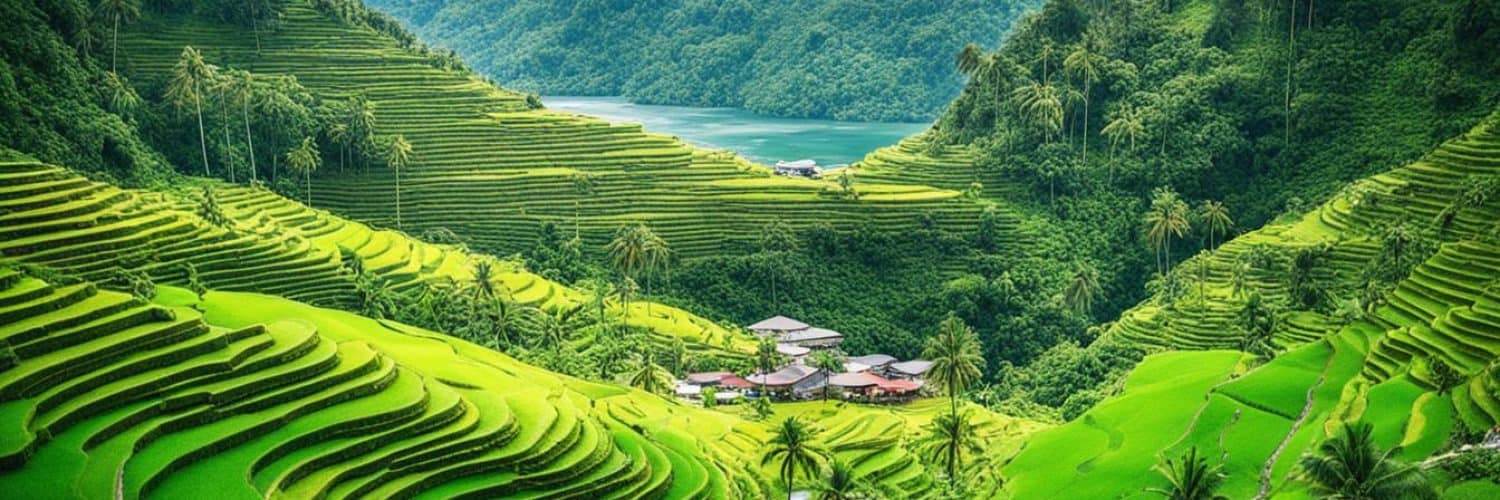
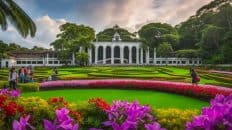
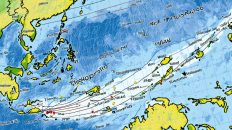
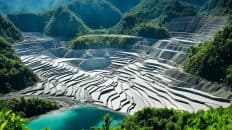










Add comment